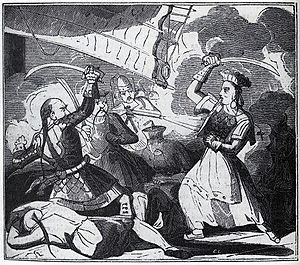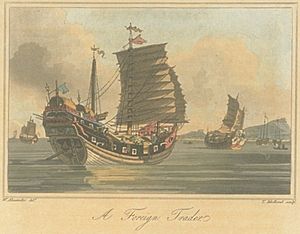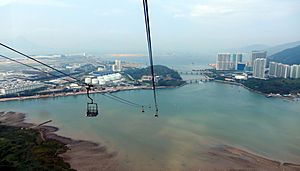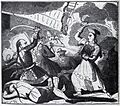Zheng Yi Sao facts for kids
Quick facts for kids
Zheng Yi Sao
|
|
|---|---|
| 鄭一嫂 | |

Zheng Yi Sao in an 1836 illustration
|
|
| Born |
1775 Xinhui, Guangdong, Qing China
|
| Died | 1844 (aged 68–69) Nanhai, Guangdong, Qing China
|
| Nationality | Chinese |
| Occupation | Pirate leader and gambling house owner |
| Criminal charge(s) | Piracy |
| Criminal status | Pacified |
| Spouse(s) | |
| Children | |
| Piratical career | |
| Other names | Ching Shih (Chinese: 鄭氏) |
| Type | Pirate |
| Allegiance | Guangdong Pirate Confederation (1805-1810) |
| Years active | 1801–1810 |
| Base of operations | Lantau Island, Guangdong, Qing China |
| Commands | Guangdong Pirate Confederation (400 ships, 40,000–60,000 pirates in 1805) Personal command of 24 ships and 1,433 pirates in 1810 |
| Later work | Gambling house owner at Guangzhou |
| Zheng Yi Sao | |||||||||||
|---|---|---|---|---|---|---|---|---|---|---|---|
| Ching Shih | |||||||||||
| Traditional Chinese | 鄭氏 | ||||||||||
| Simplified Chinese | 郑氏 | ||||||||||
| Literal meaning | wife of Zheng | ||||||||||
|
|||||||||||
| Cheng I Sao | |||||||||||
| Traditional Chinese | 鄭一嫂 | ||||||||||
| Simplified Chinese | 郑一嫂 | ||||||||||
| Literal meaning | wife of Zheng Yi | ||||||||||
|
|||||||||||
|
|||||||||||
| Traditional Chinese | 石陽 | ||||||||||
| Simplified Chinese | 石阳 | ||||||||||
|
|||||||||||
|
|||||||||||
| Chinese | 石香姑 | ||||||||||
|
|||||||||||
Zheng Yi Sao (born Shi Yang, also known as Ching Shih) was an amazing Chinese pirate leader. She was active in the South China Sea from 1801 to 1810. Many people consider her one of the most successful pirates in history. She was born in 1775 and lived until 1844.
Zheng Yi Sao married a pirate named Zheng Yi in 1801. People in Guangdong called her Zheng Yi Sao, which means "wife of Zheng Yi." After her husband died in 1807, she took charge of his huge pirate group. She had the help of Zheng Yi's adopted son, Zhang Bao, whom she later married.
As the leader of the Guangdong Pirate Confederation, her fleet was enormous. In 1805, it had about 400 ships and between 40,000 and 60,000 pirates! Her ships even fought against powerful groups like the East India Company and the Portuguese Empire.
In 1810, Zheng Yi Sao made a deal with the Chinese government. This deal allowed her and Zhang Bao to keep many ships and avoid being punished. When she surrendered, she personally led 24 ships and over 1,400 pirates. She lived a peaceful and successful life after her pirate days ended.
Zheng Yi Sao's Early Life
Zheng Yi Sao was born in 1775. Her birthplace was near Xinhui in Guangdong, China.
Joining the Pirates
In 1801, Shi Yang married Zheng Yi. He was a very well-known pirate at the time.
Zheng Yi had been a privateer, which means he was allowed to attack enemy ships by a government. He fought for the Vietnamese Tây Sơn dynasty. Later, he joined forces with Nguyễn Ánh. Zheng Yi came from a family of pirates. He also had an adopted son named Zhang Bao. Zhang Bao had joined Zheng Yi's pirate group in 1798 when he was 15 years old.
In 1802, Zheng Yi's cousin, Zheng Qi, was captured and executed. Zheng Yi quickly took over Zheng Qi's fleet. He sailed back to the Chinese coast with other Chinese pirates.
After some disagreements among the pirates, Zheng Yi Sao helped unite them. She was very good at organizing things. In July 1805, they formed a large group called the Pirate Confederation. Each pirate leader agreed to work together. The confederation had six fleets, each known by the color of its flag: red, black, blue, white, yellow, and purple. Zheng Yi led the biggest fleet, the Red Flag Fleet.
Zheng Yi Sao and Zheng Yi had two sons. Zheng Yingshi was born in 1803, and Zheng Xiongshi was born in 1807.
Becoming a Pirate Leader
On November 16, 1807, Zheng Yi died in a storm at sea. He was 42 years old. Zheng Yi Sao quickly took over his pirate operations. She had the support of Zheng Yi's nephew, Zheng Baoyang, and Zheng Qi's son, Zheng Anbang.
Zheng Yi Sao also managed the different groups within the confederation. She knew Guo Podai, the leader of the Black Flag Fleet. Most importantly, she had the strong support of Zhang Bao. Zhang Bao was already leading the Red Flag Fleet.
Zheng Yi Sao became the unofficial leader of the entire Pirate Confederation. Zhang Bao became the official commander of the Red Flag Fleet. A government official named Wen Chengzhi later reported that "Zhang Bao obeyed Zheng Yi Sao's orders, and consulted her on all things before acting." This shows how much power she had.
Leading a Huge Pirate Fleet
In 1808, the Pirate Confederation became much more active under Zheng Yi Sao's command. In September, Zhang Bao tricked and then attacked Lin Guoliang, a Chinese general. He destroyed Lin's fleet of 35 ships. A month later, Zhang Bao defeated another officer, Lin Fa. These victories greatly weakened the Chinese navy. They also opened the way for the pirates to enter the Pearl River.
The year 1809 was very busy for the Pirate Confederation. In March, a Chinese commander named Sun Quanmou, with about 100 ships, fought a small group of pirates. The pirates called Zheng Yi Sao for help. She took command of the Red Flag and White Flag Fleets. She ordered Zhang Bao to attack from the front. Other pirate leaders were to attack from the sides and rear. Zheng Yi Sao then charged in with the main part of her fleet, causing Sun's forces to retreat.
On July 21, the Chinese navy struck back. They killed Liang Bao, the leader of the White Flag Fleet, and destroyed his ships. However, Zhang Bao also defeated a Chinese general and destroyed 25 ships.
Liang's death did not stop Zheng Yi Sao. In August 1809, she ordered a huge raid. Zhang Bao raided near Dongguan, Guo Podai raided near Shunde, and Zheng Yi Sao led raids near Xinhui. Guo Podai's campaign caused many problems for the region. Zhang Bao also destroyed a large town and caused significant damage. Many villages and towns suffered from the pirates' attacks.
On September 27, Zheng Yi Sao personally led 500 ships. She ordered Zhang Bao to raid the town of Shating, where he captured many people. She also ordered Guo Podai to raid other areas.
By late October, the Chinese fleet was ready to fight again. But Zhang Bao defeated them once more on October 21.
The Great Bay Blockade
Chinese officials became desperate for help against Zheng Yi Sao. They asked the Portuguese, who controlled Macau, for assistance. The Portuguese agreed because Zheng Yi Sao had captured one of their ships earlier.
In early November 1809, Zheng Yi Sao sailed to Tung Chung Bay, north of Lantau Island, for ship repairs. On November 4, the Portuguese sent ships to bother her. She called Zhang Bao and the Red Flag Fleet for help. Zhang Bao arrived and also decided to repair his ships in the bay.
On November 8, six Portuguese ships blocked Zheng Yi Sao and Zhang Bao inside Tung Chung Bay. On November 20, 93 Chinese ships joined the blockade.
The pirates tried to break out but couldn't because of bad winds. On November 23, they captured a Chinese ship and its crew. The situation became a standoff. On November 28, the Chinese commander, Sun Quanmou, turned 43 of his ships into fireships. He sent them towards the pirates.
The pirates cleverly pulled the fireships ashore, put out the fires, and used the wood. Then the wind changed direction. Two of the fireships blew back and set two of Sun's own ships on fire! On November 29, Zhang Bao and Zheng Yi Sao used the wind to their advantage. They broke through the blockade and escaped into the South China Sea. The Chinese fleet lost 3 ships and at least 74 men. The pirates lost 40 men but no ships.
Deciding to Surrender
The year 1810 marked the end of the Pirate Confederation. There are different ideas about why the pirates surrendered.
Some believe the pirates were so powerful that they could negotiate a surrender without punishment. The government was desperate to end piracy. They were willing to make a deal to get the pirates to stop.
Another idea is that things were turning against Zheng Yi Sao. Guo Podai, leader of the Black Flag Fleet, refused to help Zheng Yi Sao during the Tung Chung Bay blockade. He even fought Zhang Bao later. On January 13, 1810, Guo Podai surrendered to the government. He was rewarded with a military rank.
The Portuguese and the British also joined the fight. British ships helped patrol the Pearl River. Portuguese ships joined the Chinese fleet.
The government also cut off the pirates' supplies. All these reasons, plus the fact that the confederation relied on a few strong leaders like Zheng Yi Sao, led her to consider surrendering.
With the help of a Portuguese official, Zheng Yi Sao, Zhang Bao, and the Chinese governor met on February 21, 1810. The talks failed at first. The government refused their demand to keep 5,000 pirates and 80 ships.
On April 17, Zheng Yi Sao went to the government office in Guangzhou herself. She led a group of 17 women and children. She negotiated directly with the governor, who finally agreed to her terms. On April 20, 1810, Zheng Yi Sao and Zhang Bao officially surrendered. They brought 17,318 pirates, 226 ships, and many weapons. Zheng Yi Sao personally surrendered with 24 ships and 1,433 pirates.
Zhang Bao was given a military rank and allowed to keep 20 to 30 ships. Zheng Yi Sao was also allowed to officially marry Zhang Bao. All the pirates were pardoned, meaning they were forgiven. They even received gifts of food and money.
Life After Piracy
After surrendering, Zhang Bao became a respected officer. He helped defeat another pirate group. Zhang Bao and Zheng Yi Sao moved to Min'an, Fujian. There, Zheng Yi Sao gave birth to their son, Zhang Yulin, in 1813.
In 1822, Zhang Bao died at age 36. He was serving as a colonel in charge of a military base. In 1824, Zheng Yi Sao returned to Guangdong with her son. In 1840, she even filed a lawsuit against a government official for stealing money Zhang Bao had given him. The case was dismissed by the emperor.
Zheng Yi Sao died in 1844, at about 68 or 69 years old. She had lived a peaceful life after her pirate adventures. She owned a famous gambling house in Guangdong.
Zheng Yi Sao in Pop Culture
Zheng Yi Sao's amazing story has inspired many movies, books, and games.
Film
- Singing Behind Screens (2003) is a movie loosely based on a story about her.
- In Pirates of the Caribbean: At World's End (2007), a character named Mistress Ching is inspired by Zheng Yi Sao.
Virtual Reality Experience
- Madame Pirate: Becoming a Legend (2021) is a VR experience. It tells a fictional story of how Zheng Yi Sao became powerful.
Manga and Graphic Novels
- In the Codename: Sailor V manga (1997), Sailor V briefly turns into Zheng Yi Sao.
- Afterlife (2006) is a graphic novel where Zheng Yi Sao is a guardian fighting demons.
- In the Korean webtoon Worn and Torn Newbie, a pirate captain named Ching Shih appears.
Television
- In the Hong Kong TV show Captain of Destiny (2015), the character Shek Kiu is based on Zheng Yi Sao.
- Crystal Yu played Zheng Yi Sao in the 2022 Doctor Who special "Legend of the Sea Devils".
Podcasts
- The BBC Sounds podcast You're Dead To Me has an episode about Zheng Yi Sao.
Video Games
- The Pirate hero in For Honor is inspired by Ching Shih.
- Baozhai from Indivisible is inspired by Ching Shih.
- Jing Lang, a bad guy in Assassin's Creed IV: Black Flag, is inspired by Ching Shih.
Music
- The song "Bloody Rose of China" by The Jolly Rogers tells her life story.
Musicals
- The musical Asian Pirate Musical features a version of her character.
Images for kids
See also






